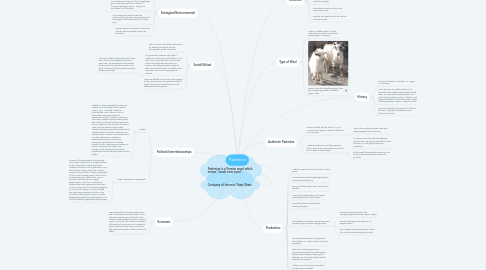
1. Pashmina is a Persian word which means “made from wool”
2. Ecological/Environmental
2.1. Production of the shawl has very little environmental affects.
2.2. The pashimina comes from the Changthangi goat under fleece which is collected through combing the goal - they don’t even need to kill the goat
2.3. The instruments used to make the pashmina (through spinning, weaving, etc.) are largely made of wood but last a long time
2.4. Transportation to customers is the main source of environmental impact (air pollution)
3. Social/Ethical
3.1. There is a lack of available information on working conditions and the demographic profile of workers
3.2. The production requires very skilled craftsmen and women, and it takes a lot of time. Thus, I speculate the main concern would most likely be these men and women not being paid well enough for their time and hard work, or children, who have been trained, are being used as workers
3.2.1. Although Ladakh is where the wool comes from, it has a low quality of life and is a poor area. The businessmen and women are the ones that make the money. Most likely, indicating that the workers are most likely not paid well.
3.3. There are little ethical concerns with regards to the materials since the goats are not hurt to get the pashmina wool since it can be obtained by combing them.
4. Political/Interrelationships
4.1. Ladakh
4.1.1. Ladakh has been contested by India and Pakistan since the dissolution of British India in 1947. Currently, Ladakh is controlled by India. There is a lack of information regarding trade and agreements in which Ladakh is involved in. Previously, Ladakhis heavily traded goods with Tibet, but when the trade agreement of 1954 between India and China ended in 1962, the Indo-Tibetan trade ended. Instead of being transported directly out of Ladakh to other countries, Pashminas are transported to a cities in India, where there are often displayed in exhibitions. Businessmen or women buy these pashminas and take them out of the country to sell to boutiques and others, or online. Companies like Yaser Shaw, however, have the pashminas made in workshops and then transport them to their buyers.
4.2. Indian International Agreements
4.2.1. In terms of the exportation of pashminas out of India, Indian trade is largely affected by the Association of Southeast Asian Nations India Free Trade Agreement (AIFTA) which allows India to trade with member countries free of tariffs. However, regardless to this, since the early 2000s, India has had an increasing trade deficit with ASEAN member countries who are largely export-driven. India also currently has bilateral free trade agreements with other Asian countries such as Thailand, Singapore, Sri Lanka and Malaysia. As seen through this, exporting pashminas to other Asian countries is the simplest. The EU is India’s biggest trading partner, however there is no FTA but there are negotiations taking place.
5. Economic
5.1. Yaser Shaw shawls can be bought online and in boutiques around the world. Since authentic pashminas are difficult to find, they are usually expensive (around $150 or more). Due to this, the consumer market is often well-off individuals. For hundreds of years, pashminas have been a symbol of high status and wealth, and this is still valid today.
6. Company of Interest: Yaser Shaw
7. Type of Wool
7.1. Made in Ladakh region of Indian Administered Jammu and Kashmir (India’s region of Kashmir)
7.2. Comes from the changthangi goat, from the Changthang plateau in Kashmir region, India
8. History
8.1. Founder of Pashmina Industry: Mir Sayyid Ali Hamadani
8.2. When he came to Ladakh (Kashmir), he found that the Ladakhi goats produced soft wool. He made socks and gave them as a gift to king of Kashmir, Sultan Kutabdin, and suggested to the king that they start a shawl weaving industry in Kashmir using this wool.
8.3. Pashmina blankets are a symbol of status in the East – royalty and elites have worn them for centuries.
9. Authentic Pashmina
9.1. Pashmina fibres are fine and thin (12-15 microns), while generic cashmere fibres are 15-19 microns
9.1.1. Due to this, pashmina fibres make light weight apparel like fine scarves
9.2. Authentic pashmina is usually expensive ($150+) due to its rarity and the amount of time it takes to manufacture
9.2.1. The wool comes from the Changthangi breed of the capra hircus goat which makes less than 0.1% of global Cashmere production
9.2.2. Due to small fibre diameter, pashmina has to be hand-processed and woven into products
10. Production
10.1. Authentic pashminas are very hard to come across
10.2. The pashmina goat/changthangi sheds its winter coat every spring
10.3. One goat sheds approx. 80–170 grams of the fibre
10.4. In spring (moulting season), the goats naturally shed their under fleece
10.5. The under fleece is collected by combing the goat
10.6. The traditional producers of pashmina wool in Ladakh region are the Changpa tribe
10.6.1. Nomadic people that live in the Changthang plateau of the Kashmir region
10.6.2. The winter temperature drops to -40 degree Celsius
10.6.3. The Changpa rear sheep in harsh climes for meat and pashmina goats for wool

